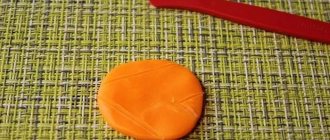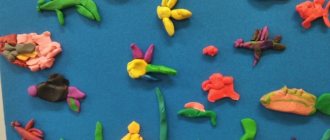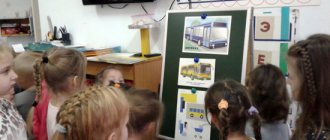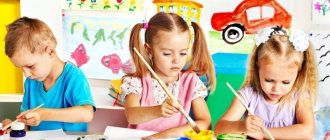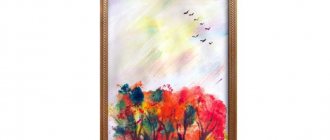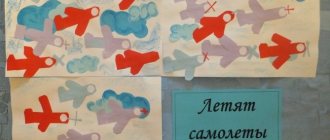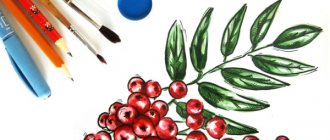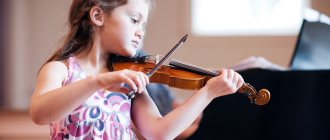Pedagogical advice on organizing drawing classes in the middle group
Children of middle preschool age begin to show cognitive interest in creativity. Using various figures of speech, children learn to express their opinion regarding the picture they like and give basic arguments in favor of the artistic means that were used to convey the images.
The teacher begins to introduce children to folk toys: Dymkovo, Filimonov. They are so bright and expressive that they immediately attract children with their colorful images. In the middle group, classes in decorative drawing are introduced, during which, during a preliminary conversation, the teacher shows works of Russian traditional folk crafts. Children decorate doll dresses, scarves, aprons, sundresses for matryoshka dolls with different patterns. To develop children's imagination, it is advisable to cut out the outlines of a Dymkovo or Filimonovskaya toy from white cardboard or paper, which children place on sheets of paper decorated with patterns. Children will see an interesting painted toy, reminiscent of a folk one.
Before depicting an object, the teacher teaches children the ability to master its shape, study the image as a whole, without losing sight of the details important for this object. To add expressiveness to children's drawings, you can offer them paper of different shapes and colors. The teacher offers compositional and plot options, since for four-year-old children this task presents a certain difficulty, especially at the beginning of the school year. However, in the second half of the year, the teacher should gradually involve children in the process of coming up with the plot and compositional structure of the drawing. Thus, the teacher sets the task of motivating children to portray not only characters, but to supplement the plot with other details. For example, when drawing chickens, draw grass and flowers.
In drawing classes, you can use traditional drawing techniques using colored pencils, wax crayons, gouache, and watercolors. You can combine drawing media: watercolor and wax crayons. Among non-traditional techniques, finger painting and poking (for decorating testicles) may be interesting.
Develop interest in visual arts
The theme “Simple and Golden Eggs” allows you to develop interest in various types of visual activities, that is, along with drawing, the teacher can use modeling, for example, on the theme “The Ryaba Hen laid eggs”, and applique on the theme “Multi-colored Easter eggs”, “Let’s decorate” eggs for grandma." One of the most interesting non-traditional techniques is modeling from salt dough, which has a number of advantages over using plasticine. Salt dough is completely safe, molds well without sticking to your hands, does not stain the work surface and is easy to clean, and the main thing is that crafts made from such dough can be dried and painted during drawing classes or during joint activities between the teacher and children. The tradition of modeling from salt dough, already known in Rus', is being revived, providing opportunities for creativity.
The teacher can offer individual tasks to children who show special interest and ability in drawing. For example, decorate the testicles with a pattern using non-traditional drawing techniques (finger painting, painting with cotton swabs). You can also draw a chicken that has hatched from an egg using the palm painting technique. Children should find the idea of using semolina fascinating, drawing the outline of a testicle, then smearing it with glue and sprinkling it with semolina. This kind of assignment turns a learning session into a real creative process, and the children feel like artists.
Learn to come up with compositions
Composition plays an important role in the artistic development of children starting from early preschool age. In each subsequent age group, compositional solutions become more complex, an artistic concept appears, which the child tries to express through different types of visual activity. Children 4–5 years old need sensitive pedagogical guidance, that is, the teacher offers them various compositional solutions, creative tasks, coming up with something new each time. When children at the beginning of the school year master simple techniques for depicting objects of various shapes, then in a lesson on drawing simple and golden eggs it is difficult to talk about the large variability of compositional solutions. However, in the second half of the year, children are already mastering the skill of decorative drawing, mastering various techniques of brush painting, and we can talk about the complication of plot and compositional lines. One interesting option could be a collective composition of Easter eggs or multi-colored eggs in a basket. The composition can be complemented by a chicken or an Easter bunny.
Motivate creativity
At the beginning of the lesson, the teacher devotes several minutes to activating the cognitive activity of children, using various gaming techniques. By combining the rich world of play with the educational process, the teacher makes completing any task interesting. Thus, children should have play motivation. As a motivating start, you can use a shadow theater with the production of the fairy tale “Ryaba Hen”, a didactic game with your favorite characters. The teacher, together with the children, can act out a scene based on a fairy tale, or when a hen and chicks come to visit. Children will be interested, as they themselves will be involved in the production. The teacher can start the lesson by telling a fairy tale or reading a story, learning poetry, or using musical accompaniment.
Examples of author's notes for drawing classes in the middle group
When drawing up lesson notes, you need to pay attention to the sequence and types of work that are planned to be involved and correctly allocate time for each educational stage:
- Preliminary work (2–3 minutes)
- Main part (10–13 minutes)
- Physical education minute (1–2 minutes)
- Final part (summarizing) (2 minutes)
HE. Mishchuk. Drawing lesson on the topic “Simple and golden eggs for the Ryaba chicken”
By developing an interest in creativity, we cultivate personality.
Example of drawing lesson notes
| Organizational educational activities | ||
| Kind of activity | Topic/Materials | Objectives/Program content |
| Drawing | “Simple and golden egg” Materials. White, yellow gouache, sheets of light green, light blue paper, brushes, jars of water. | To consolidate knowledge about the oval shape, the concepts of “sharp” and “blunt”. Learn to draw oval objects. Practice the ability to paint over an image without going beyond the outline. Develop children's imagination. |
| Lesson stage | GCD content | |
| Preliminary work | Consider the peculiarity of the appearance of the testicle in order to consolidate the knowledge that one end is sharp and the other is blunt. | |
| Main part | Conversation with children The teacher tells the children that today Ryaba the chicken came to visit them for class. She came straight out of a fairy tale. Invites children to remember its contents by showing a shadow theater. Children remember that at the end of the fairy tale, the mouse broke an egg, and the hen promised to lay a golden egg for their grandparents. The teacher says that since the chicken was not simple, but fabulous, she decided to come to visit you guys so that you, too, would feel like heroes of a fairy tale and draw eggs for your grandparents. One plain and one gold. The teacher offers to read a poem to the chicken. The Pied Hen, a kind fat girl, walks around the yard, calling the children: - Co-co-co, guys, where are you chickens, Yellow lumps, daughters and sons? Hurry to mom: we will eat seeds and crumbs with you, get out the spoons. Here are some more riddles to solve. She leads the chickens with her, like a nanny in a kindergarten. (Chicken) She clucked: “I’m a big bird!” Look, she brought a yellow egg!” And she went outside to brag... (Chicken) “Chick-chick-chick! Where, where, where!” - We hear it on the street. Ryabenkaya calls all the chickens... (Chicken) Now let's draw our chicken's testicles. The teacher asks what shape the egg is. (Oval). Show pictures of eggs, Ryaba chicken with eggs. Remember that they have already drawn and sculpted oval-shaped objects. First, the teacher offers to show the movement with a finger or brush in the air, how they will draw an egg. Explanation of the drawing scheme. | |
| Physical education minute | Gymnastics “Little Chicken” A mischievous chicken lived, twisting its head all day long. He turned left and right, bent the left leg, then raised the right one, and stood on both again. He began to flap his wings, raising and lowering. Up, down, up, down. Leaned left, right. It's good in the world, really! | |
| Final part (summarizing) | Let's look at how beautiful your testicles turned out. Do you like your drawings? Ryaba the hen is also happy, cackling: “Ko-ko-ko, what great guys! Grandfather and grandmother will be happy with such testicles.” The hens give away their drawings. Exhibition of children's works. In the center of the composition is an image of Ryaba the hen, surrounded by children's works. You can place it on a large sheet of paper or on a stand. | |
Steps for Drawing Plain and Golden Eggs Explained
The teacher should pay special attention to explaining all the stages of drawing an egg.
- Place a sheet of paper horizontally. On the left side of the sheet we draw a simple egg, on the right - a golden one. You can draw a simple egg on one sheet, and a golden egg on the other. (Figure 1, 2).
- Start painting a simple testicle from above with white gouache, rounding the tip, move the brush smoothly, without stopping, expanding the testicle at the bottom (blunt tip of the testicle), return to the top point, narrowing the testicle from above.
- Paint the egg with white gouache. Remind that you need to paint carefully, in one direction, without going beyond the contour. (Figure 3).
- Using the same technique, draw a golden egg with yellow gouache. (Figure 4).
Tinted light blue sheet of paper
Toriated light green sheet of paper
Simple testicle
Golden egg
Pictures to show children
The hen Ryaba laid eggs, simple and golden.
The chicken laid a simple egg
White testicle
Brown egg
The hen laid a golden egg
Sparkles in the sun
A fairy egg for grandparents
Fairytale eggs
If in the first half of the school year children draw objects that are fairly simple in shape, then by spring they already have the skill of decorative drawing, that is, they can decorate their drawings with patterns (dots, circles, stripes, strokes). Therefore, on the eve of the celebration of the bright spring holiday of Easter, the teacher has a great opportunity not only to tell children about the holiday - history, features of the celebration, symbols - but also to organize an interesting thematic lesson. The first stage is sculpting Easter eggs, then painting them. You can sculpt the eggs during a sculpting class or during joint activities between the teacher and children. Paint sculpted testicles during a decorative drawing class.
HE. Mishchuk. Decorative drawing lesson on the theme “Getting ready for Easter”
Lesson notes on decorative drawing
| Organizational educational activities | ||
| Kind of activity | Topic/Materials | Objectives/Program content |
| Drawing | Decorative drawing Materials. Gouache of different colors, eggs made from salt dough, brushes, jars of water. | Learn to decorate oval-shaped objects. Expand your horizons, knowledge about Russian holidays, culture, traditions. Develop imagination. Cultivate neatness. |
| Lesson stage | GCD content | |
| Preliminary work | Talk about Easter, traditions of its celebration, symbolism. Look at the pictures with painted eggs. Discuss what pattern elements can be used to decorate Easter eggs. | |
| Main part | Conversation with children Drops are dripping loudly near our window. The birds sang merrily, Easter came to visit us. K. Fofanov The teacher talks about Easter. Easter is the main holiday of all Christians, it is very bright and kind. On this day, all people bake Easter cakes, make Easter cottage cheese and paint eggs. The egg is a symbol of life and its rebirth. The eggs are painted in different colors and given to relatives and friends with the words: “Christ is risen!” In response, you need to say: “Truly he is risen!”, kiss each other as a sign of forgiveness and love for loved ones. The teacher reads a poem about the Easter egg. Look what a miracle Mom put in the dish? There is an egg, but not a simple one: Golden painted, Like a bright toy! There are stripes, curls, many small rings, stars, circles and hearts. What are all these colors for, Like in a good old fairy tale? Mom gave everyone the answers: “Easter is the brightest holiday!” And the egg, I know, is a symbol of life on earth! T. Lavrova Easter is a symbol of spring, faith, love. And today the Easter bunny came to visit us, which is a symbol of Easter in other countries. He came a long way to come visit us. Let's, guys, please him and paint the eggs that you and I made from dough. They have already dried and are waiting for us to beautifully decorate them with Easter patterns. The teacher shows pictures with painted Easter eggs. Discusses with children what elements can be used for decoration. The teacher asks you to show imagination and accuracy while painting the testicles. Explanation of the drawing scheme. | |
| Physical education minute | Gymnastics “Little Children” We use our hands – “clap-clap”, We use our legs – “top-stomp”, We use our shoulders – “chick-chick”, We use our eyes – “blink-blink”, Once there, once there Turn around. They sat down once, they stood up twice, they all raised their hands up. One, two, one, two It’s time for us to get busy. | |
| Final part (summarizing) | The teacher invites the children to look at how beautiful their eggs are and arrange an exhibition so that moms and dads can look at their work. If the eggs were voluminous, then after drying they can be put in a basket and placed next to the Easter bunny. If the eggs are flat in shape, then you can tie multi-colored ribbons and, together with the children, decorate the willow branches that the Easter bunny brought them for the holiday. | |
Explanation of the stages of decorating Easter eggs
The teacher should pay special attention to explaining all the stages of painting an Easter egg.
- The teacher kneads the salt dough, and the children sculpt eggs, which they will decorate during the drawing lesson. You can add gouache or natural dyes (carrot or beet juice) to the dough, then the eggs will turn out colored. (Figures 1, 2).
- Depending on the general level of training of children and individual characteristics, they can sculpt flat, egg-shaped or voluminous ones. If the blanks are flat, then the teacher can make holes at the top so that the finished work can then be hung on a stand. (Figures 3, 4, 5).
- Flat blanks are placed on the work surface, voluminous children hold both ends with the fingers of their left hand and paint. Then the teacher helps them turn the piece over, and the children decorate the egg on the other side. At the end of the work, place the eggs on a stand to dry further. You can use plastic bottle caps as a stand. (Figures 6, 7).
- When drawing stripes, move the brush smoothly, without lifting off the surface.
- We draw flowers using the dipping technique.
- We draw dots and circles with the tip of the brush. You can also perform them using the unconventional technique of poking with a cotton swab.
Kneading salt dough
Dough modeling
Dough egg
Molded eggs Blanks for decoration
Painting Easter eggs
Painting Easter eggs
Pictures to show children
Easter bunny
Rabbit and chicken
The rabbit decorates the egg The rabbit comes to visit
Bunny getting ready for Easter
Bunny gives an Easter egg
A cheerful rabbit is waiting for guests
Painted Easter eggs
Bright patterns
Reds are beautiful
Flower dots
Delicate daisies
Colored Easter
Curls
Stripes
Tenderness
Joyful Easter
Circles
Stripes and dots
Different patterns
Examples of children's work
Simple pattern
From salt dough
Painted eggs
Let's decorate Easter
Let's celebrate Easter
From salt dough Decorating willow
In the middle group, the path to unlocking the creative potential of preschoolers becomes an exciting journey for both the teacher and the children. The teacher is constantly looking for new ideas to involve children in the world of beauty, and children, in turn, in small steps learn the wonderful world of aesthetics of the world around them, moving from simple to complex. From simple lines and shapes to more complex compositions in which the artistic intent is already visible. The article provides interesting ideas on how to diversify and make drawing classes fun. The proposed author's lesson notes can serve as the basis for further pedagogical developments.
Golden egg
We will need:
- Chicken egg
- Leggings or nylon tights (we won’t cook them, so nothing will happen to them)
- Flashlight (any one will do, even on a phone)
First, shine a flashlight on the egg to check its color. The egg should glow.
Tie a knot in the tights, place an egg in them and tie on the other side.
Next we have two
option:
First option
You simply spin the egg non-stop and swirl it for about 2 – 5 (the more the better) minutes.
In this case, you simply swap the whites and yolks.
.
Second option
You still spin the egg for about 2 minutes, but every 5 - 10 seconds you stop the rotation, sharply spreading your arms to the sides.
In this case, the yolk and white will mix
and the whole egg will turn out yellow.
Take the egg out of the tights and check it with a flashlight; it should no longer glow.
If it still glows, then the rotation procedure must be repeated.
Then just hard boil the egg (7 – 10 minutes). After cooking, place in cold water to remove the shell better.
That's all! If you followed the first option, you will get something like this:
And if according to the second, then something like this:
Liked? Subscribe to the channel, rate and share on social media. networks!

